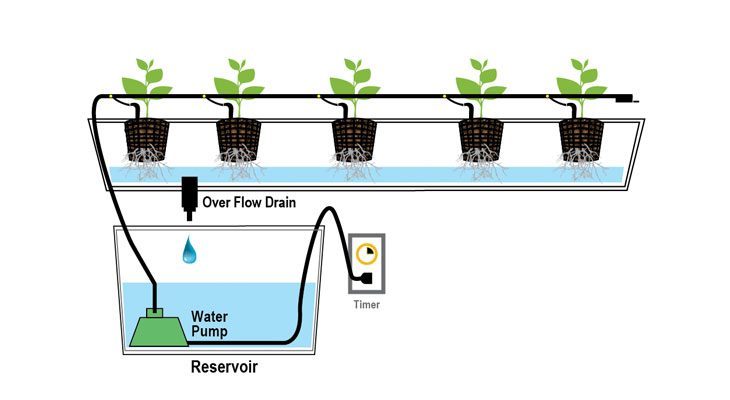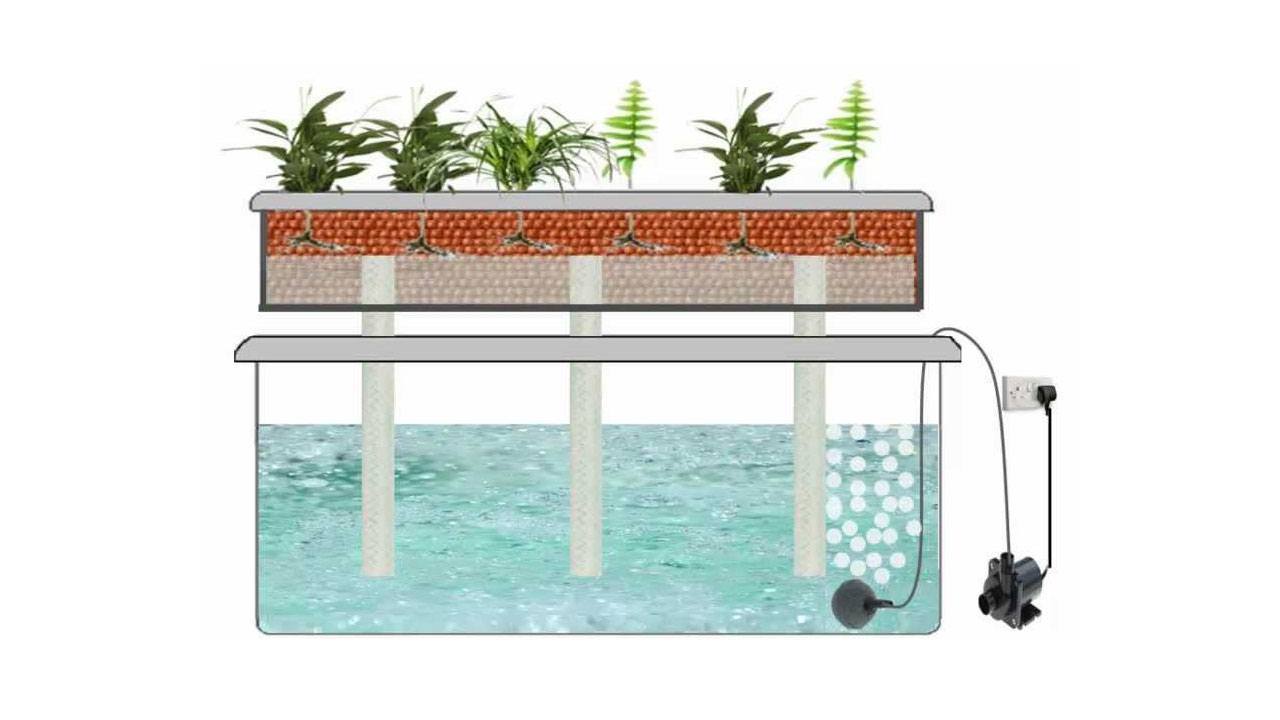HYDROPONIC
Hydroponics is a subset of hydroculture, which is the growing of plants in a soil less medium, or an aquatic based environment. Hydroponic growing uses mineral nutrient solutions to feed the plants in water, without soil.
For those of us who love growing plants these are exciting times indeed. We are no longer limited by climate or by season in the pursuit of our harmless pleasures. We can now grow virtually any plant at virtually any time of the year – the only limitation is our imagination. The simple, effective hydroponic systems now available, coupled with modern horticultural lighting, have transformed our hobby and freed us to grow our favourite plants where and when we choose.
TYPES OF HYDROPONIC
There are six main types of hydroponic systems to choose from:
- Wick Systems.
- Deep Water Culture (DWC)
- Nutrient Film Technique (NFT).
- Ebb and Flow (Flood and Drain)
- Aeroponics.
- Drip Systems.
Wicking Systems
A wicking system is the most basic type of hydro system you can build. It's been used for thousands of years, though it wasn't considered a hydroponic system back then.
It's what's known as passive hydroponics, meaning that you don't need any air pumps or water pumps to use it.
Nutrients and water are moved into a plant's root zone via a wick, which is often something as simple as a rope or piece of felt.
One key to success with a wicking system is to use a growing media that transports water and nutrients well. Good choices include coconut coir, perlite, or vermiculite.
Wick systems are good for smaller plants that don't use up a lot of water or nutrients. Larger plants may have a hard time getting enough of either via a simple wick system.
Benefits of Wick Systems
- Truly "hands off" if you set it up correctly
- Fantastic for small plants, beginner gardeners, and children
Downsides of Wick Systems
- Not good for larger plants
- Incorrect wick placement or material can mean death for your plants
Deep Water Culture (DWC) Systems
Deep water culture, which I will refer to as DWC from here on out, is hands-down the easiest type of hydro system to use.

How a Deep Water Culture (DWC) system works.
In a DWC system, you use a reservoir to hold a nutrient solution. The roots of your plants are suspended in that solution so they get a constant supply of water, oxygen, and nutrients.
To oxygenate the water, you use an air pump with an air stone to pump bubbles into the nutrient solution. This prevents your roots from drowning in the water — a weird thing to think about, but it can (and does) happen to many beginner hydroponic gardeners.
Your plants are typically housed in net pots that are placed in a foam board or into the top of the container that you're using for your reservoir. With some hydroponic growing media added into your net pots, they provide a home for the very beginning of your root system and plant stems.
Benefits of Deep Water Culture
- Very inexpensive and easy to make at home
- Extremely low-maintenance
- Recirculating, so less wasted inputs
Downsides of Deep Water Culture
- Does not work well for large plants
- Does not work well for plants with long growing period
Nutrient Film Technique (NFT) Systems
The Nutrient Film Technique, which I will refer to as NFT, is a popular commercial hydroponic system.
Plants are grown in channels that have a nutrient solution pumping through them and constantly running along the bottom of the channel. When the solution reaches the end of the channel, it drops back into a main reservoir and is sent back to the beginning of the system again. This makes it a recirculating system, just like deep water culture.
Unlike deep water culture, your plants roots are not completely submerged in a NFT system — hence the "film" part of the system's name.
Plants are placed in these channels using net pots and growing medium and can be replaced or harvested on a one-by-one basis.
Benefits of Nutrient Film Technique
- Minimal growing medium needed
- Recirculating system means less waste
Downsides of Nutrient Film Technique
- Pump failure of any kind can completely ruin your crop
- Roots can become overgrown and clog the channels
Ebb and Flow / Flood and Drain Systems
Ebb and Flow systems, which are also known by the name Flood and Drain, are a less-commonly seen system. But they're still quite effective and can be the best choice depending on your situation.
Unlike the previous two hydro systems we have covered, an ebb and flow system does not expose the roots of your plants to nutrient solution on a constant basis.
Instead, you grow in a tray filled with a growing medium. The tray is "flooded" with your nutrient solution a few times per day, depending on factors like:
- The size of your plants
- The water requirement of your plants
- The air temperature
- Where your plants are in their growth cycle
- ...And many more
Flooding is accomplished by using a reservoir below the tray, a water pump, and a timer to schedule the flooding cycle.
After the tray is flooded, gravity drains the solution back down into the reservoir, where it is being oxygenated by an air pump and air stone. It sits there waiting for the next flood cycle, and the process goes on.
Hydroponic growers choose ebb and flow systems for their flexibility. Most of them will fill the tray with a growing medium of their choice and also add net pots to organize their plants and control the roots a bit more.
Benefits of Ebb and Flow
- Efficient use of water and energy
- Highly customizable to your specific needs
Downsides of Ebb and Flow
- Roots can dry out quickly if environmental conditions are off or the pump or timer fails
- Uses a lot of growing medium
Aeroponics Systems
Aeroponic systems are the most "high-tech" hydroponic setups that you can build. But they're not that complex once you understand how they work.
An aeroponic system is similar to a NFT system in that the roots are mostly suspended in air. The difference is that an aeroponic system achieves this by misting the root zone with a nutrient solution constantly instead of running a thin film of nutrient solution along a channel.
Some growers prefer to mist on a cycle like an ebb and flow system, but the cycle is much shorter, typically only waiting a few minutes between each misting. It's also possible to mist on a continual basis and use a finer sprayer to ensure more oxygen gets to the root zone.
Aeroponic systems have been shown to grow plants even quicker than some of the simpler systems like deep water culture, but this has not been verified to be true in all cases. If you want to experiment with this system, you will need specialized spray nozzles to atomize the nutrient solution.

Benefits of Aeroponics
- Roots often are exposed to more oxygen than submerged-root systems
Downsides of Aeroponics
- High-pressure nozzles can fail and roots can dry out
- Not as cheap or easy to set up as other methods
Drip Systems
Drip systems are extremely common in commercial operations, but less common in recreational gardens. This is because they're simple to operate a a large scale, but slightly overkill for a smaller garden. Regardless, they're a great way to grow hydroponically that you should consider.

Benefits of Drip Systems
- High level of control over feeding and watering schedule
- Less likely to break
- Relatively cheap
Downsides of Drip Systems
- May be overkill for a smaller garden
- Fluctuating pH and nutrient levels (if using recirculating system)





No comments:
Post a Comment